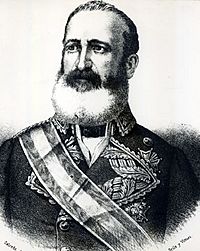Carlos María de la Torre y Navacerrada facts for kids
Quick facts for kids
Carlos María de la Torre
|
|
|---|---|
 |
|
| 82nd Governor-General of the Philippines | |
| In office 23 June 1869 – 4 April 1871 |
|
| Monarch | Amadeo I of Spain |
| Succeeded by | Rafael de Izquierdo |
| Personal details | |
| Born | 27 February 1809 Seville |
| Died | 2 December 1879 (aged 70) Madrid |
Carlos María de la Torre y Navacerrada (1809–1879) was an important Spanish soldier and leader. He served as the Governor-General of the Philippines from 1869 to 1871. Many people remember him as one of the most liked Spanish Governors-General in the Philippines. He was known for bringing new, fairer ideas to the islands.
Contents
Governor-General of the Philippines
Carlos María de la Torre was a military officer from Spain. He was sent to the Philippines after a big change in the Spanish government. He believed in liberal ideas, which meant he wanted more freedom and fairness for people. He tried to bring these ideas to the Philippines through new laws.
New Rules and Changes
De la Torre made many changes during his time. He started the Guardia Civil in the Philippines, which was a police force. He also offered a fresh start to people who had rebelled. One famous rebel leader, Casimiro Camerino, was given a chance to join this new police force.
He stopped the practice of flogging, which was a harsh punishment using whips. He also made it easier for newspapers to publish without strict checks. He started to make education less controlled by religious groups.
Working with Filipinos
De la Torre was friendly with a group of educated Filipinos called the ilustrados. These Filipinos understood the situation in the Philippines under Spanish rule. His supporters even held a parade in front of the Malacañan Palace to show their support for his liberal ideas.
Soon after he arrived, some important Filipinos like Burgos and Joaquín Pardo de Tavera led a peaceful protest. They called for "Viva Filipinas para los Filipinos!" which means "Long live the Philippines for Filipinos!" In 1870, students at the University of Santo Tomas also asked for changes in their school. They even supported the idea of the Philippines becoming a province of Spain, with more self-rule.
His Time in Office Ends
Carlos María de la Torre was a single man. He had a companion, Maria del Rosario Gil de Montes de Sanchiz, who was quite influential. She wrote a book that some people criticized because it was written by a woman.
During a party at Malacañang Palace, she wore a ribbon that said "Viva la Libertad" (Long live liberty) and "Viva el Pueblo Soberano" (Long live the sovereign nation). This showed her support for freedom and the power of the people.
In March 1872, de la Torre asked to leave his post. However, the person who supported him in Spain had passed away the month before. Orders for his replacement were already given before his letter was written. He was followed by Governor-General Rafael de Izquierdo, who had very different, less liberal ideas.
Images for kids
See also
 In Spanish: Carlos María de la Torre y Navacerrada para niños
In Spanish: Carlos María de la Torre y Navacerrada para niños


